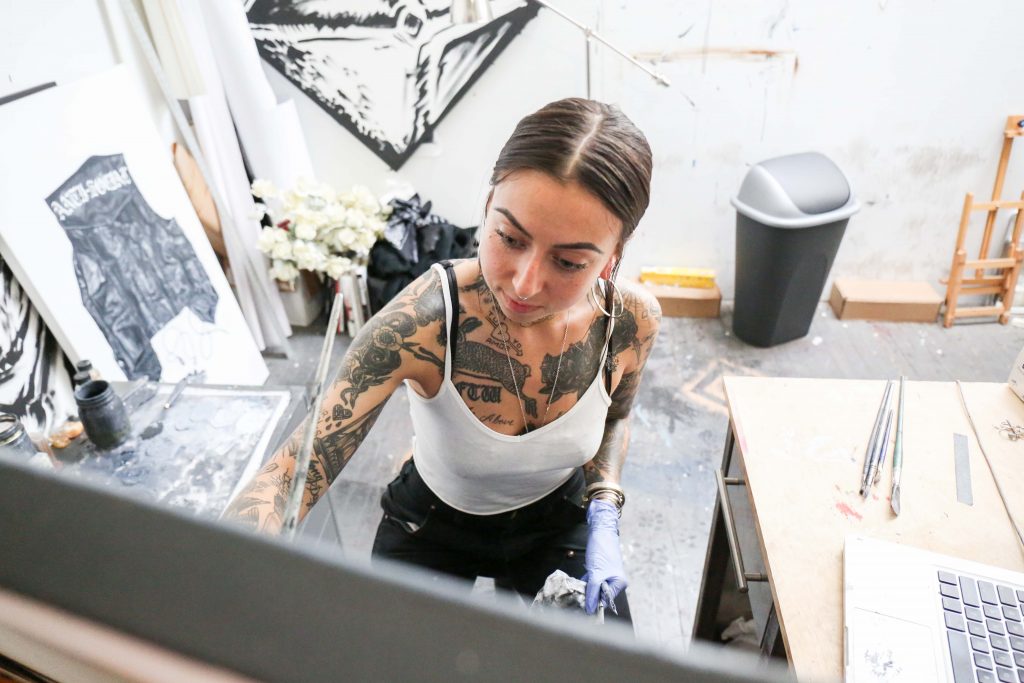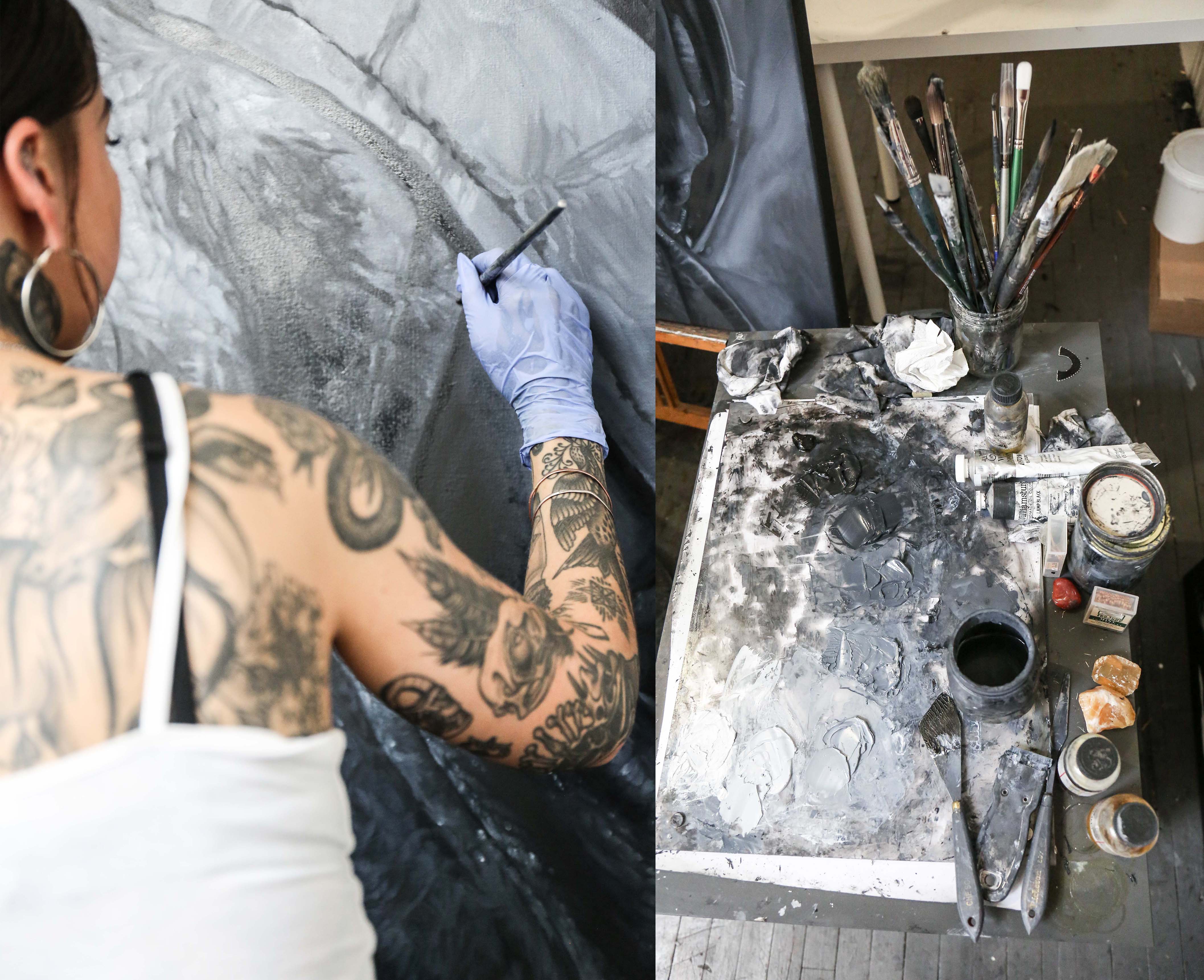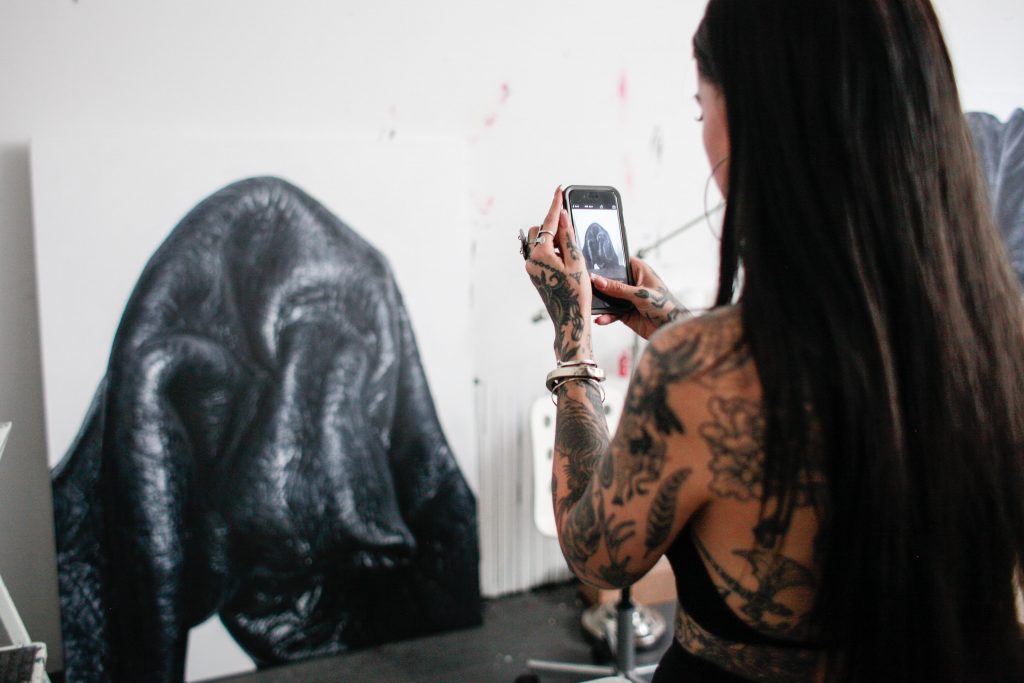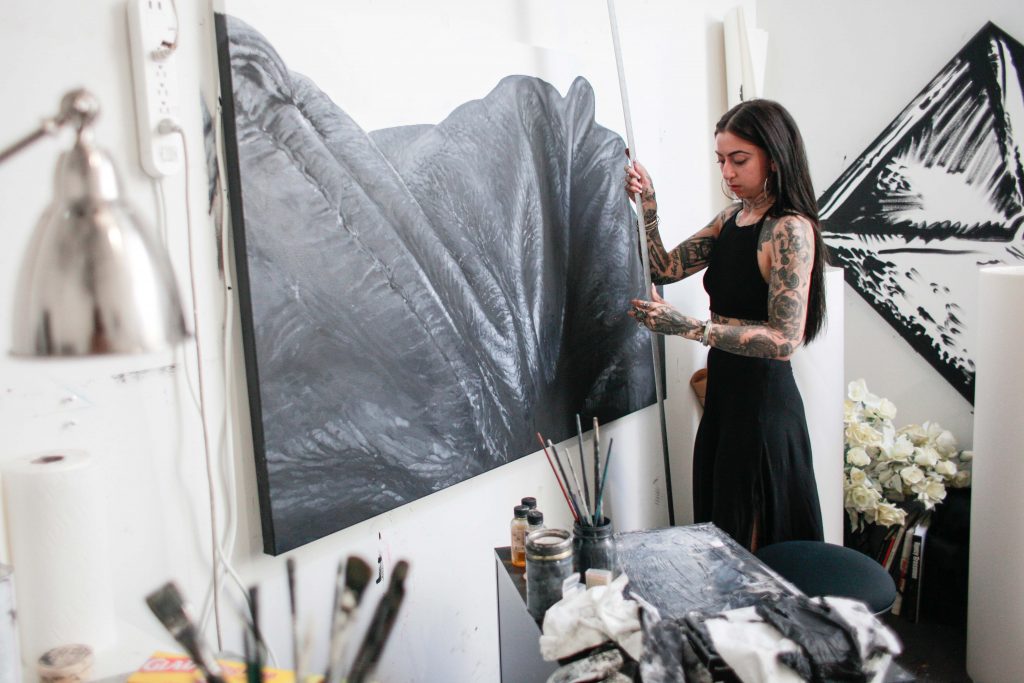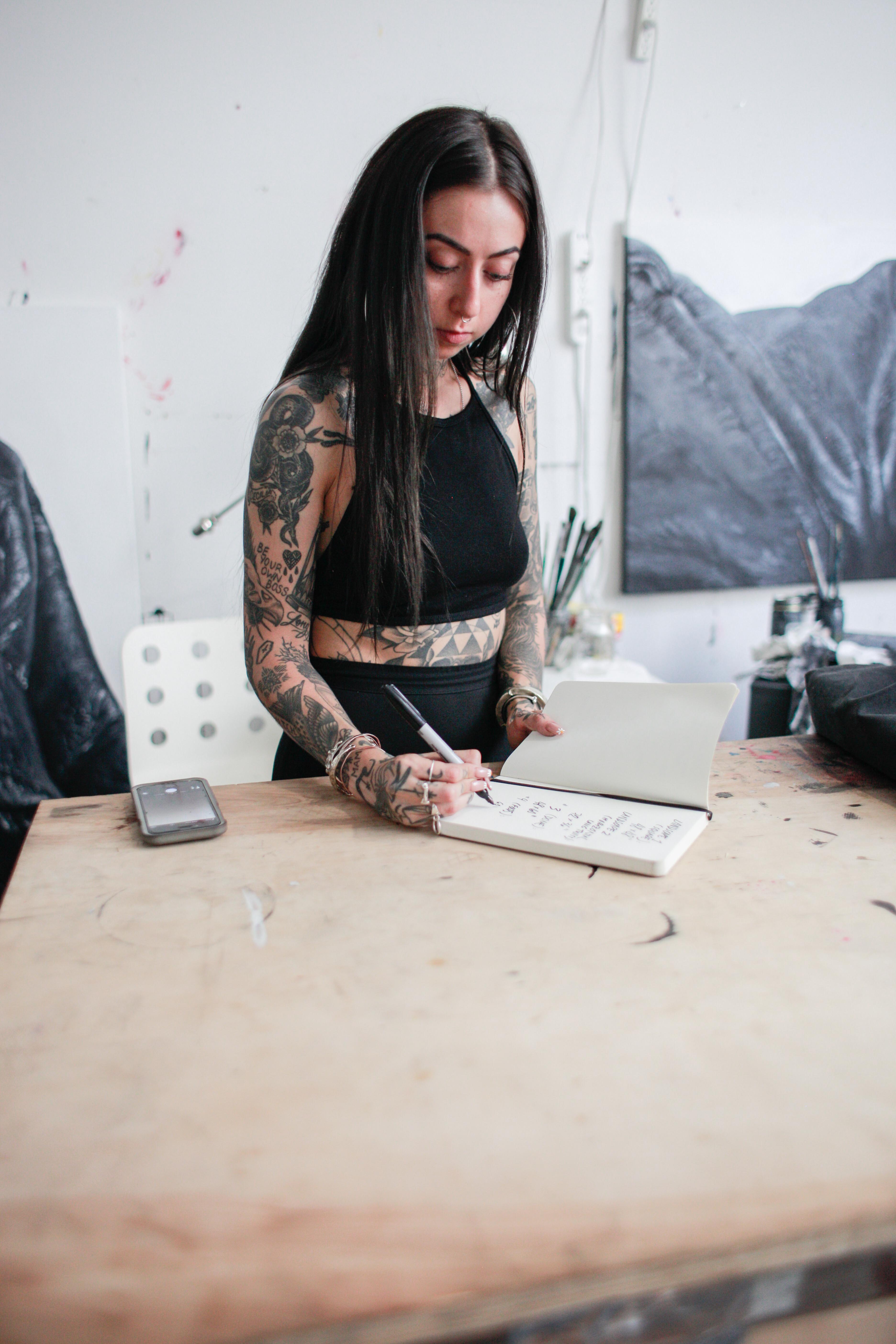Tamara Santibañez’s is one of the busiest tattoo artists in Brooklyn – and also one of the baddest. Bouncing between coasts, she puts on art shows in LA, heads her publishing house Discipline Press in New York, and in between finds time to ink the skin of avid fans at Saved Tattoo, where clients flock for her signature mix of Chicano art motifs and kink imagery. A scroll through her Instagram reveals her West Coast-style tattoos of sad girl cholas, dominating femmes, punk babes, leather gloves, whips, chains, and gimp masks. Somehow, she juggles it all with a fresh manicure of coffin-tip claws and a smile.
Santibañez grew up in Georgia, and early on fell in with the punk and anarchist scene there. But like most Chicanas living outside major Latino hubs, she often felt on the edge of her cultural roots. It was only when she learned more about Chicano politics and came across cult Chicano zines like Teen Angels, Cholo Style, and Mi Vida Loca mags that she began to see imagery that she connected with on a deeper level.
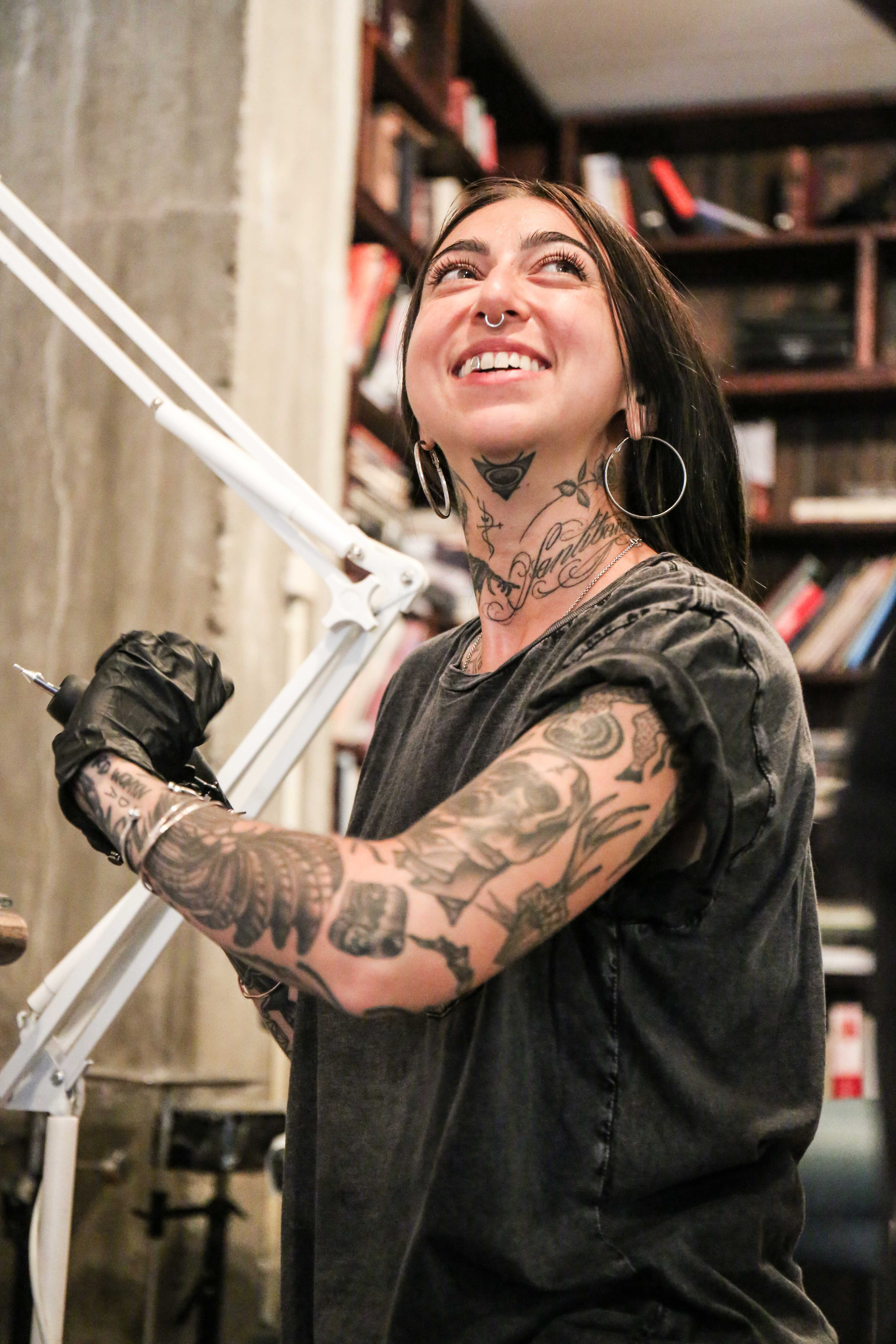
Collectively, Santibañez’s work deals with the link between identity and the objects or symbols we associate with our bodies. As an artist working with charged imagery, she spends a lot of time thinking about the power of symbols and iconography– and what happens when they are divorced of their context. For instance, the prison-style tattoo style she occasionally references was once seen as naive and a lesser form of art in the tattoo world. Now, any bearded hipster can sport a teardrop face tattoo or Old English neck tat as part of a trend. In order to contextualize the aesthetic, she collaborated with Ricardo Montenegro (@Mr.1777) to begin the Chicano History poster series, a project highlighting people like Chicana civil rights worker Jovita Idár or the historical boycott against the Coors Brewing Company in 1966. “There is an enormous amount of culture and history behind a cool tattoo or a cool drawing,” she explains.
Named one of the top 6 tattoo artists in New York City by Complex magazine, Santibañez is also a self-described leather fetishist, a theme she explored heavily in a recent Los Angeles solo show of her paintings, titled ‘Landscapes’. The massive oil paintings in grayscale magnify a small area – the armpit or shoulder fold – of a leather jacket she wears often. It’s a form of abstract self-portraiture that allows the viewer to examine an intimate symbol of Santibañez’s identity.
Just before her solo show, we caught up with Tamara to talk about her Chicano art influences, gender fluidity, kink-friendly practices, and just being a hardworking Chicana punk.
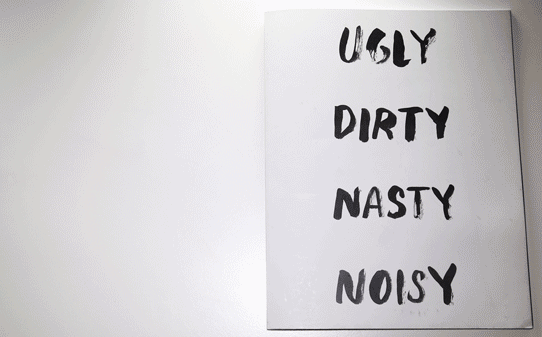
How did the influence of Chicano art enter your work?
When I was younger I was becoming political and getting into anarchism, seeing a lot of Zapatista-related artwork, political artwork, distro imagery, woodcuts, and that kind of stuff. There’s a major overlap with that and Mexican art and radical Mexican art. When I started seeing the Chicano-style stuff, there was a major overlap with all I had seen before. The DIY element felt familiar from all the punk stuff I was drawing and other friends were making for bands, zines, and things like that. Teen Angels is a zine in a lot of ways. At least the original incarnations of it is, and a lot of those magazines are so DIY, so that felt very familiar.
In the punk scene there were things that were meaningful to me but being punk and aligning with Mexican anarchism or like Zapatistas felt tokenizing. Seeing Chicano work felt more relevant. Also, my family isn’t super traditional. My mom is really cool with me having tattoos, which was another thing people would say when they were arguing with me on whether I was Mexican or not. They’d say, “But you have so many tattoos?” Seeing Teen Angels and similar work, I was like, “Yea these are tattoos by and for Mexican people.” It felt validating for there to be a style all our own. It felt a lot more authentic than, say, Sailor Jerry designs. That stuff is fun to tattoo but it just doesn’t connect with me on the same level.
These are tattoos by and for Mexican people. It felt validating for there to be a style all our own.
I feel like you’re super New York and have a very specific New York vibe, but you reference a lot of LA style in your work. What is your relationship with LA?
Because I’ve lived in New York for so long I had imagined a combative relationship with LA. People in LA and NYC love to hate on each other, but when I went there I knew it was the origin point for all of this art I felt really connected to. I think I had this image in my mind of LA being full of celebrity-obsessed, flaky people, but when I started going there it was just so cool and there’s something about it that felt so comfortable – especially in places like East 7th, a specifically Chicano DIY punk space. The politics of the punk scene there are very focused on Chicano issues and the particular struggles of that community.
Here in New York, a lot of the time I felt very disconnected from that. I felt I was trying to carve out space for my own identity in places where it didn’t really exist already, and I felt I constantly had to assert it in a way. Here in New York, I’m pretty white-passing and people don’t often think I’m Chicana. In LA, people have a multifaceted view of what it means to be Chicana and it made me more at ease and comfortable. People wouldn’t be like “Oh my God you speak Spanish?!” They’d say, “Yes of course you speak Spanish. We all speak Spanish.”
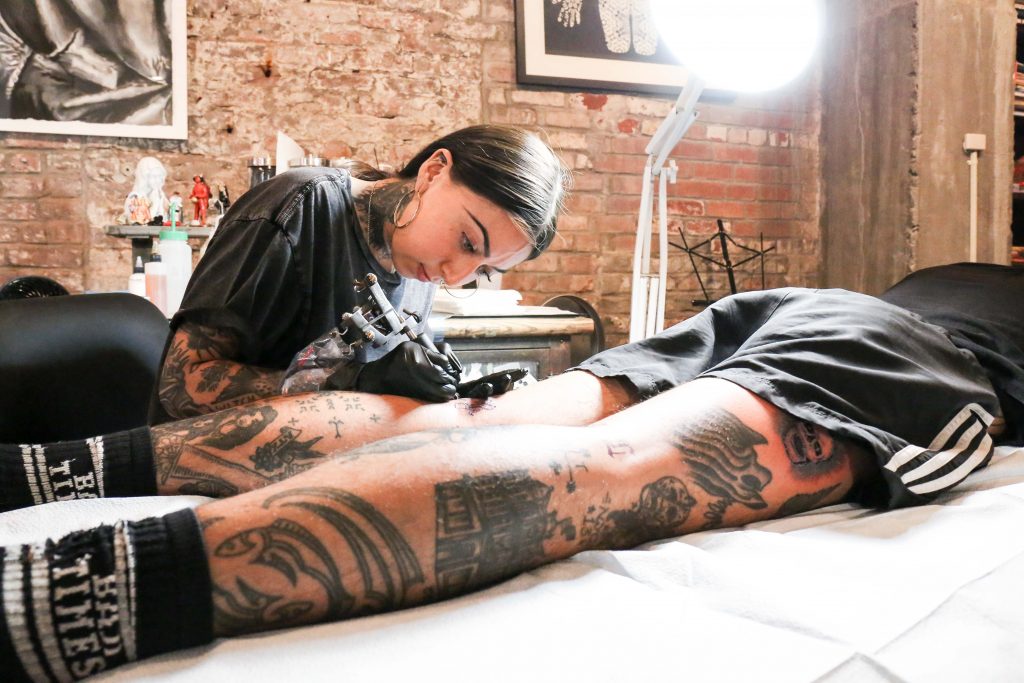
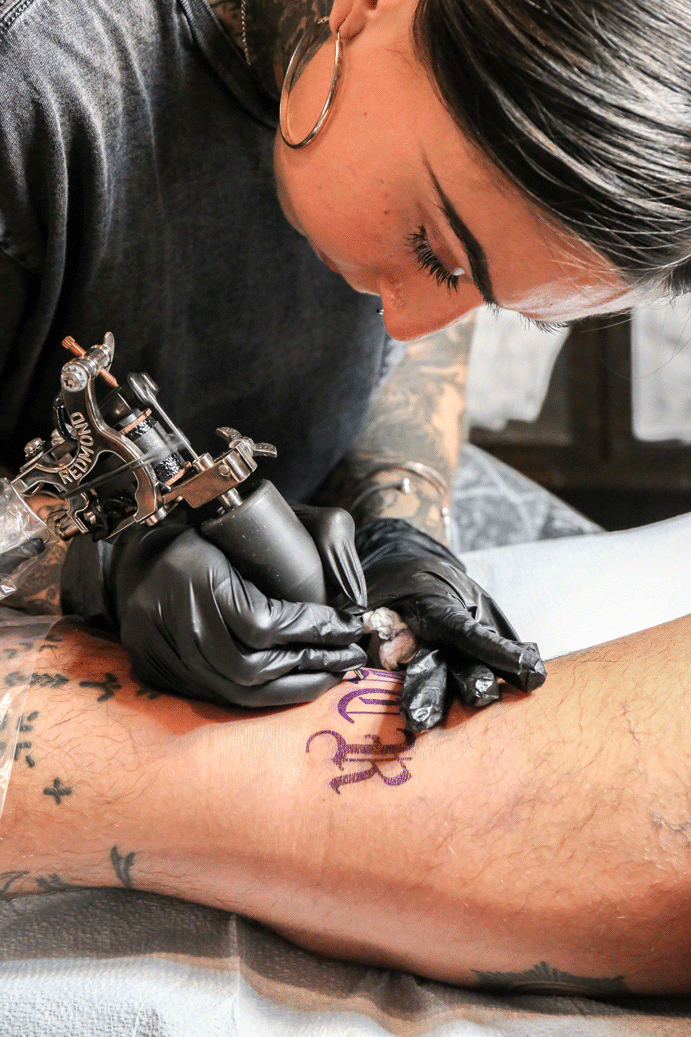
Let’s talk about appropriation with people who get tattoos. Is this a problem you see often given the nature of your particular style?
It is a difficult topic. I don’t consider myself the gatekeeper of who does and doesn’t deserve to have a particular type of image tattooed on them, but I am sensitive to it because I am mixed race and I’m not from the the West Coast and I didn’t grow up with that culture. And I have thought about my relationship to it. But it’s very obvious when people are thoughtless when they approach it. People just think it looks cool and they don’t think about it beyond that. It’s an enormous privilege to say, “I like that I’ll have it now,” and not have anyone question them on it.
The problem is most people aren’t malicious about it either. They are just ignorant to the issues it presents. I’ve had people say some crazy things to me, some casual racism type of stuff. People make offhand remarks about how they want to get these tattoos from me but they would never get tattooed in LA because it’s too sketchy. People have said that more than once to me. I’m always like why?? It’s a crazy thing to say.
You’re incredibly talented as an illustrator and tattooer. And now you have been published in Teen Angels, a magazine you initially looked to for inspiration. That must feel really good…
That was such a crazy bucket list moment for me because it’s such a staple and standard point of reference. Everyone looks at it. Not even just being in Teen Angels but being in it alongside the work of people who I admire. It wasn’t even just exciting or glamorous. It felt validating because I try to be respectful to the work, do it justice and represent a broader picture of it. And also bring my own flavor to it.
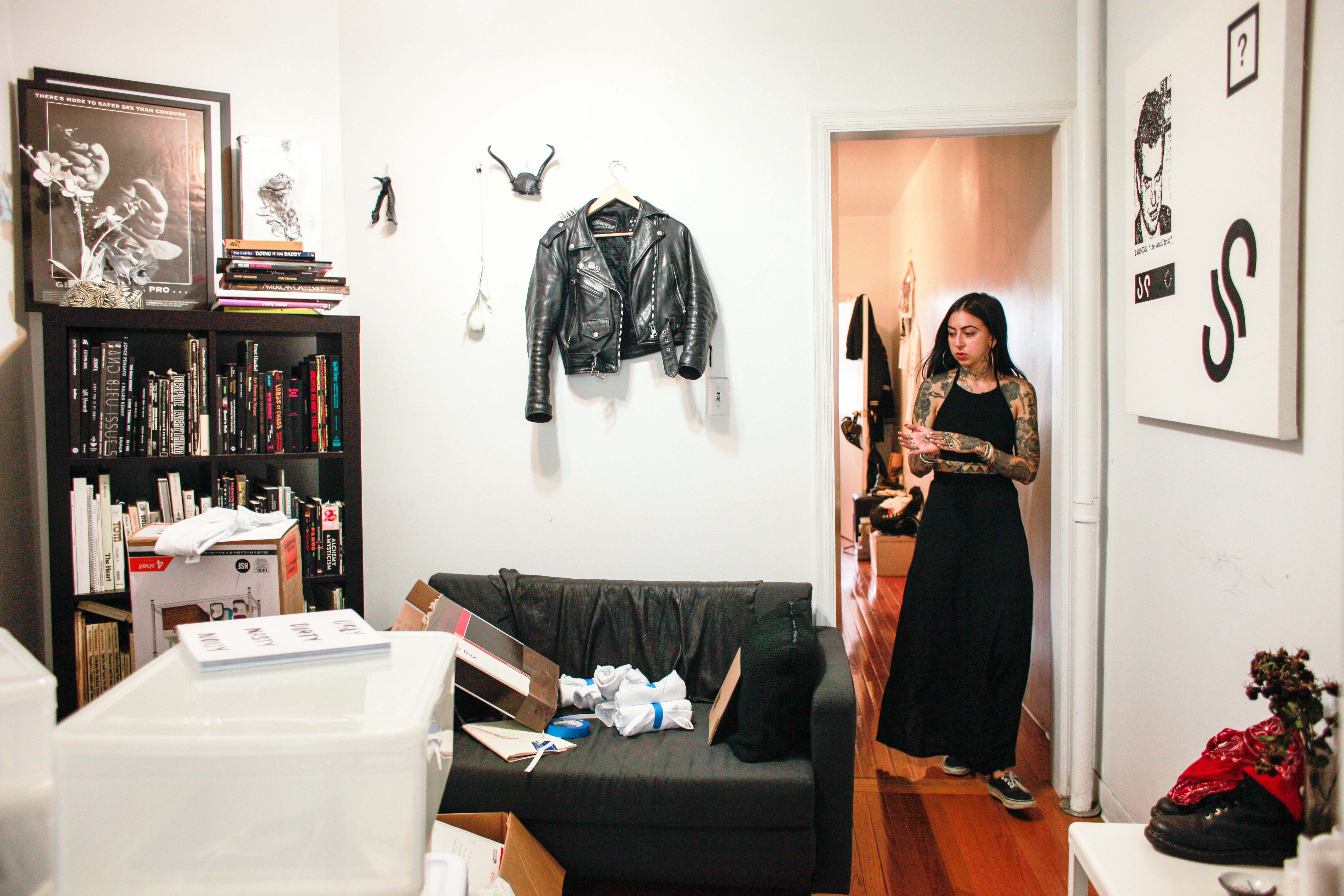
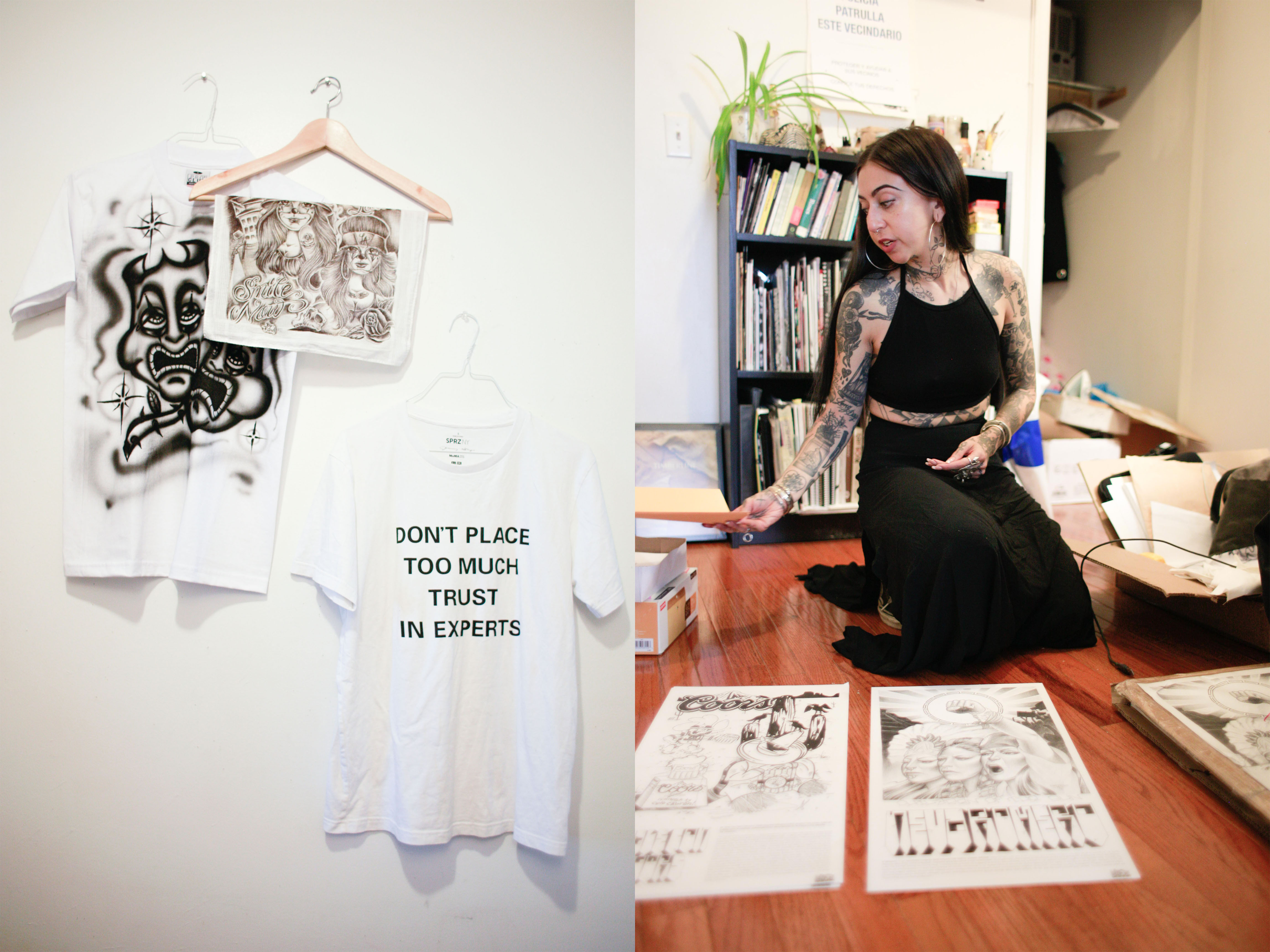
You’re also doing this Chicano History Poster Series. What was the idea behind this project?
On Instagram, I always wanted to repost everything from @mr.1777 because I felt everybody should be reading his posts about different historical events or people in Mexican and Chicano history. I decided I wanted to do this poster series because I wanted to see his posts get a signal boost but also have them in a more tangible format. I also considered the political climate. It’s been super frustrating to watch the news. It’s a scary time.
I felt like somebody should be making this. People might look at my artwork and not otherwise see the information. I’m trying to present that there is an enormous amount of culture and history behind a cool tattoo or a cool drawing. I see it removed from that history in a lot of ways, especially on Instagram. The format does not lend itself to seeing a deeper story or context. That stuff has become really popularized.
I also want to find a way to integrate the prisoner art aspect of it. I don’t know the best way to do it yet. It is often neglected. People like the idea of prison style, but they don’t connect it to the contemporary reality of prison and of people who are incarcerated. There are really cool publications that are sharing the artwork now. Ink from the Pen is one created by Pamela Delgado. Her husband is incarcerated and she does a magazine that is all prisoner art. People want to see this as history or give it relic status but it’s not.
Tattooing has historically been a male-dominated field, but at your home tattoo shop, Saved, you said you actually work with a lot of women. How is working there?
I love working there. It gives me a rose-colored view of tattooing sometimes, because the shop I work at is very inclusive and intentional about being inclusive. I don’t have to deal with weird passive aggressive ego shit or people undermining me with weird comments. It’s not like that in the broader world of tattooing. I’ve identified as female up until pretty recently, but I feel more nonbinary at the moment. That’s something I can feel comfortable with at my shop. I don’t have to talk about it or assert it. The thought of trying to assert that more widely in tattooing is an exhaustive prospect. Most people don’t have the framework to understand gender expansiveness. I’m glad that on a daily basis I can be in a place where I don’t have to think about it and I can feel fluid there. But then I will always have a rude reality check when some male tattooer says, “Well don’t you think that the reason you’re so busy is because you’re a cute, young girl.” Somebody said that to me a month ago, like straight up. It’s ignorant.
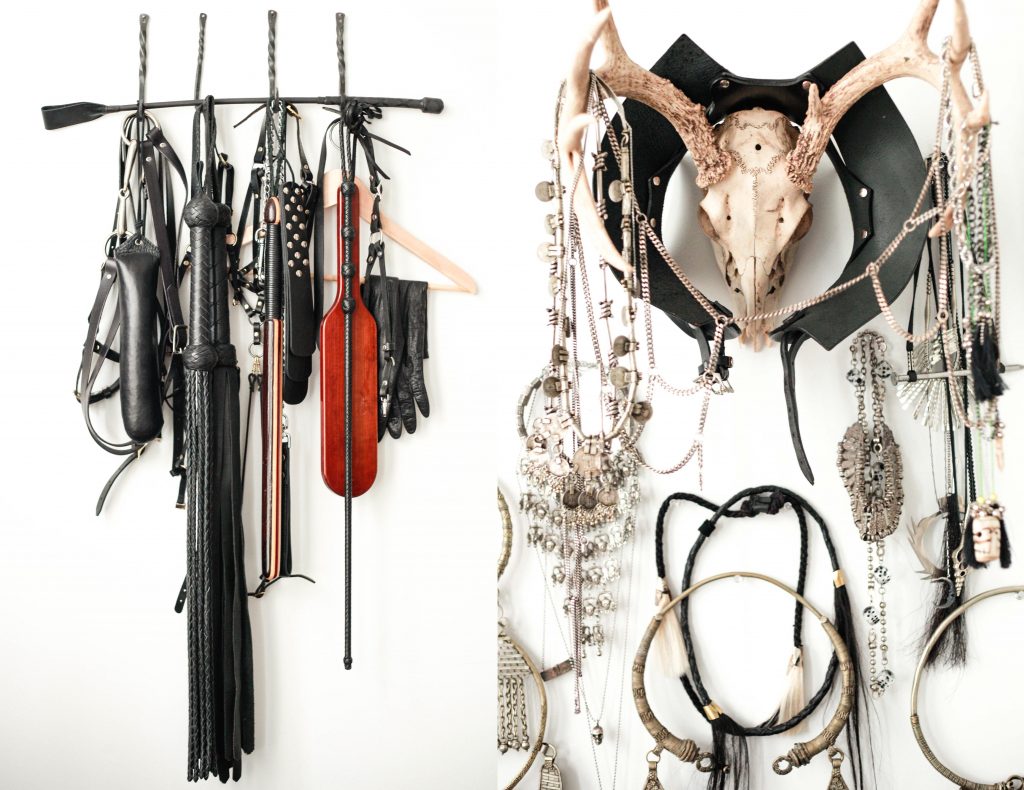
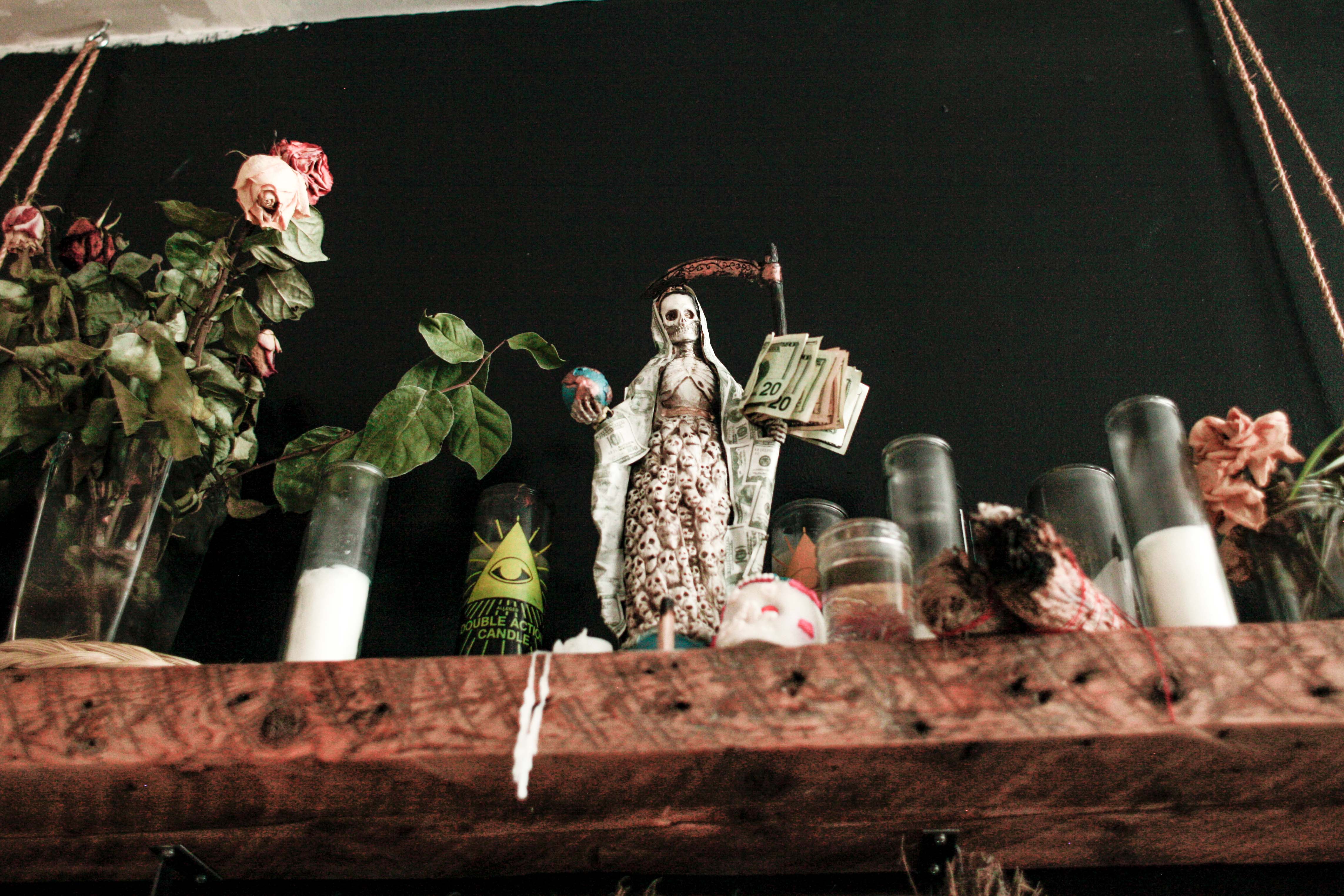
When did fetish and BDSM imagery become a part of your work? Is kink something you want to be less of a taboo?
That’s a multifaceted question. Since I was a kid I’ve always been into punk and metal or taboo and subcultural imagery. It’s always been who I am. I think that kind of imagery is so ingrained in punk and goth aesthetics to begin with, that it stopped feeling shocking to me a long time ago. Four years ago, the only people who would get that kink-type imagery tattooed were extremely antisocial and did not give a single fuck about what people thought of them, or they were involved in fetish professional communities. They weren’t “regular” people. Now it’s definitely grown in popularity especially here in New York.
I’ve gotten a reputation as a good tattooer in the kink community. I just registered a listing on the Kink Aware Professionals network so now I have an ad as a kink-friendly tattooer. It’s important to me to let people know I provide a space where people can come for a tattoo that deals with kink and they’re not going to get shade, attitude, or weirdness about it.
I would say kink is more in the public consciousness now, but I think I had hoped with the rise in conversation about different genders and sexual identities, that people talk about kink in a more constructive and liberating way. I don’t necessarily think is the case. The way I see it represented is extremely heteronormative and very reliant on the gender binary. To me, it seems disproportionate the way that male dominance and female submission is the default when people think about kink. If anything, I would like it to be de-stigmatized and for people to be comfortable talking about it, because there are so many things the straight world could learn about their own sexuality and relationship practices from kink community practices: like negotiation, open communication, talking about your sexual preferences, likes and dislikes, and limitations.
Tell me about the paintings in your solo show opening at Slow Culture.
This is my most ambitious work so far because it’s the biggest. I obviously have a leather fetish but there’s a lot of levels to the work besides it just being a fetish thing. I called them landscapes because I wanted them to feel like a monument or a terrain that you’re immersed in. People have a lot of emotional reactions when they look at them. In a way they’re repulsive and visually heavy because they’re so dark. People see things in them that aren’t there, like vaginas and hooded faces. They engage people’s imaginations in an interesting way that’s kind of revealing.
